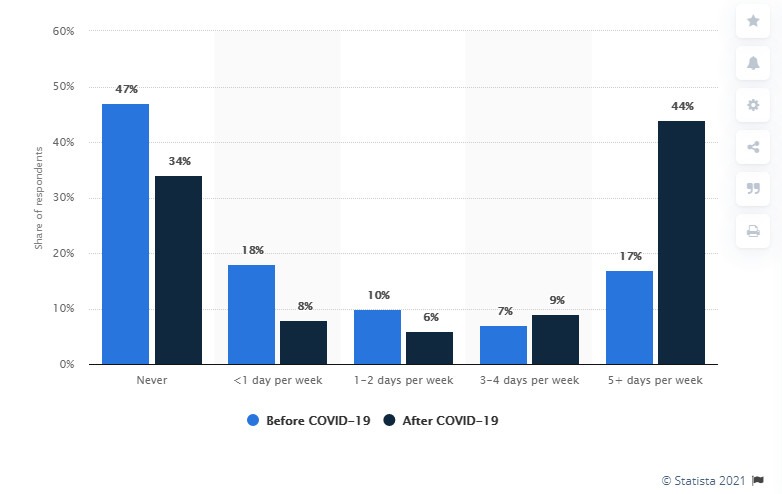Prior to the pandemic, there were many companies that did not allow employees to work remotely. In fact, some of these were strongly opposed to the concept. The landscape has certainly changed, and quickly. In fact, Statista points to data on the use of remote work before COVID-19 and more recently which creates an interesting “U-shaped” curve.

Suddenly, even the most steadfast opponents of remote work had to cave in, admit defeat, and, if they wished to stay in operation, allow employees to work from remote locations. Over the past several months this forced experience has revealed a number of former myths of remote work.
Manar Morales and Ivan Misner explored these myths of remote work in a recent Harvard Business Review article, labeling them as the “5 C’s”:
- Loss of control
- Loss of culture
- Loss of collaboration
- Loss of contribution
- Loss of connection
Here we take a look at each of these and how organizations can take steps to minimize or eliminate the potential for these losses.
Myth 1: Loss of Control
Traditionally, loss of control has one of the primary driving forces behind many supervisors’ and managers’ hesitance to allow employees to work from home. Experience has borne out that this concern has been largely unnecessary. In fact, as Morales and Misner point out, managers can successfully address the potential for loss of control through structure and clarity.
“To maintain control and smooth operation of your organizations, it’s imperative that you set standards and clearly communicate them,” they write.
Myth 2: Loss of Culture
Loss of culture is another concern that has been widespread but that organizations are able to address and overcome if they are mindful of the potential for this loss to occur and actively take steps to keep it from happening. In fact, through our research, we have found that not having a firm view of remote structures is what can lead to cultural issues.
Some companies are simply not communicating clearly and effectively about why some employees can work from home and others can’t. In addition, they’re failing to be proactive in supporting the desired culture among both remote and on-site employees. What we’ve found is that digital workforce leaders are far less likely than digital workforce laggards to say that there is a cultural divide between those who can and can’t work remotely (29% vs. 45%).
Myth 3: Loss of Collaboration
The fear of losing opportunities for collaboration and the innovation it can inspire was behind Marrissa Mayer’s well-known banning of working from home for Yahoo staff when she assumed the role of CEO back in 2013.
Over the course of the pandemic organizations of all kinds have found it possible to effectively collaborate with staff, customers, and others by leveraging a wide range of technology tools—like Zoom, Slack, and others—to foster these important interactions.
Myth 4: Loss of Contribution
This myth, according to Morales and Misner, is related to managers’ tendency to believe that “If employees are not physically at their desks in the office, then how will we know that they’re actually working?” It’s a myth that has a relatively simple fix — shift from evaluating performance based on time put in, to a focus on measurable outcomes and performance objectives.
“All employees should be evaluated on the quality of their work and their ability to meet clearly defined performance objectives, rather than on time spent in the office,” they write. We would add that this applies to employees who are on-site as well as those working remotely.
Myth 5: Loss of Connection
There’s no doubt that millions of people in both work and home settings are forever grateful for tools like Zoom to allow them to continue to stay connected with colleagues, friends, and family during the pandemic. Despite ongoing lamentations about “Zoom fatigue,” the truth is that these tools made an already very difficult situation more bearable for many.
Those digital connections aren’t likely to go away any time soon. Morales and Misner point to research from BNI of 2,300 people around the world indicating that, even after the pandemic, 16% would like to continue holding meetings online only and a little over half (51%) would like to see some type of hybrid approach.
We’ve had many a-ha moments during the pandemic about how the new digital ways of working are providing big benefits that hadn’t previously been anticipated. What a-ha moments have you had? How do you plan to continue to leverage the lessons you’ve learned as more employees return to the workplace?



